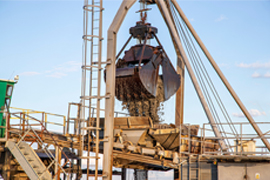ENGINEERED MATERIAL HANDLING
Material Handling is defined as, “The movement of raw materials, semi-finished goods, and finished articles through various stages of production and warehousing is called material handling.” Engineered Material Handling is concerned with the movement, storage, and control of materials in a (production) process.
At Tega, Engineered Material Handling refers to the design, development, and implementation of specialized systems and equipment for the efficient and safe movement, storage, and transportation of materials within a facility or industrial setting. This field is essential in various industries, including manufacturing, distribution, and logistics, to ensure the smooth and reliable flow of materials and products.
KEY ASPECTS OF ENGINEERED MATERIAL HANDLING
Key aspects of Engineered Material Handling include Conveyor Systems, Engineered Chutes & Storage Systems. Engineered Chutes are designed to control and direct the flow of materials efficiently, often from higher elevations to lower ones or between processing equipment. Engineered Chutes play a critical role in material handling systems, helping maintain material handling flow, minimize material handling loss, and reduce the need for manual labour.
KEY FEATURES & FUNCTIONS OF ENGINEERED CHUTES
Key features and functions of Engineered Chutes in bulk material handling include:
Controlled Flow: Chutes are designed to ensure a controlled and predictable flow of materials, preventing material handling spillage, segregation, and irregular discharge that can lead to production inefficiencies and safety hazards.
Wear Resistance: Chutes are often lined or constructed with materials resistant to wear and abrasion to withstand the constant flow of bulk materials.
Impact Reduction: Chute designs can incorporate features to reduce the impact of falling materials, preventing degradation and excessive dust generation.
Material-specific Design: Chutes are customized to suit the specific characteristics of handled materials, considering particle size, moisture content, and abrasiveness.
Transition Points: Chutes are frequently used at transition points between different equipment, ensuring smooth material handling flow within a material handling system.
Loading and Discharging: Chutes facilitate loading materials into storage containers or discharging materials into hoppers, silos, or other processing equipment.
Slope and Design Variations: Chute designs can vary in slope, shape, and internal features based on the specific application and materials being handled.
Maintenance Considerations: Proper maintenance and inspection of chutes are essential to ensure continued effectiveness and prevent blockages or material handling build-up.
TYPES OF ENGINEERED CHUTES
There are several types of chutes used in material handling, each designed for specific applications and materials. These chutes serve different purposes and are chosen based on the requirements of the bulk material handling system. Common types include:
Transfer Chutes: Facilitate smooth and controlled material handling transfer between conveyors or from a conveyor to a bin, silo, or processing equipment.
Hood and Spoon Chutes: Contain and control material handling discharge from a conveyor or other equipment to reduce wear and dust generation.
Cascade Chutes: Enable a steep and controlled descent of materials, often used in mining and bulk material handling applications.
Telescopic Chutes: Used for loading bulk materials into vehicles and can extend or retract to reach different loading points.
Liner Chutes: Designed with wear-resistant liners to protect against abrasion and minimize wear and tear.
Vibration Chutes: Use controlled vibration to facilitate the material handling flow of materials, particularly helpful with materials prone to bridging or hang-ups.
Spiral Chutes: Gently and quickly convey materials in a continuous, descending flow, commonly used in warehouses and distribution centers.
Escape Chutes: Designed for emergency evacuation from elevated locations, providing a safe and controlled descent for personnel.
Inclined Chutes: Used when materials need to flow at an angle or be elevated within the material handling system.
Curved Chutes: Designed to change the direction of material handling flow, redirecting materials from one conveyor or processing equipment to another at an angle.
The choice of chute type depends on factors such as the characteristics of bulk materials, flow rate, required trajectory, and surrounding equipment. Proper chute design is essential to ensure efficient and safe material handling transfer while minimizing wear and material handling degradation.
ASPECT OF USING TEGA WEAR-RESISTANT LINERS IN ENGINEERED CHUTES
Wear-resistant liners are a crucial component in engineered chutes used in material handling systems. In Tega, these liners are designed to protect the chute's surface from the abrasive wear and impact caused by the flow of bulk materials, extending the chute's lifespan and reducing maintenance and replacement costs.
Key Aspects of Wear-Resistant Liners in Chutes:
Material Selection: Wear-resistant liners are typically made from durable materials resistant to abrasion, including rubber, ceramic, and polymer liners.
Liner Installation: Liners can be installed through welding, bolting, or adhesion, depending on chute design and requirements.
Thickness and Wear Plates: Liners vary in thickness, and some chutes may use multiple layers, including base plates and overlay wear plates, providing additional protection against wear.
Regular Inspection and Maintenance: Despite their durability, regular inspection and maintenance are necessary to ensure effective material handling performance. Prompt replacement of damaged or worn-out liners maintains chute performance.
Cost Savings: Using wear-resistant liners leads to significant cost savings by reducing the need for frequent repairs and replacements, minimizing downtime in material handling operations.
Wear-resistant liners play a vital role in extending the life of chutes in material handling systems, contributing to the overall efficiency and productivity of industrial operations.
.jpg?v=1)


